Chase Center, Two Years Later: Golden State Warriors Find Production Groove for Post-COVID Era
Director, Scoreboard Operations, Scott Heitman is keeping content and technology fresh
Story Highlights
Stephen Curry and the Golden State Warriors are on the doorstep of another deep postseason run. Playing in San Francisco’s Chase Center, which is touted as one of the most high-tech arenas in the National Basketball Association, the team is getting an extra jolt from fans and the in-venue entertainment crew. Since opening in 2019, the building has been transformed in response to new technologies and for the eventual aftermath of the COVID-19 pandemic.
“[The pandemic] was an odd experience for us at the beginning, but we learned to make the most of it,” says Scott Heitman, director, scoreboard operations, Golden State Warriors. “We learned how to change our control room into a virtual environment.”
Game-Day Responsibilities: Lower-Bowl Activations, Exterior Board in Thrive City
Heitman joined the Warriors in February 2019. At the time, Chase Center was still a construction site and was seven months from its official September 2019 opening. From the beginning, he became an integral part of bringing the current technologies to the control room and assembled a star-studded team that would help him.
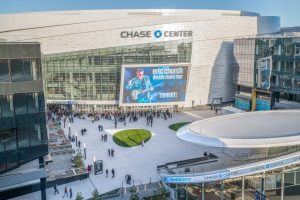
Thrive City, the district surrounding Chase Center, is anchored by a 75-ft. LED videoboard.
Now housed in a SMPTE ST 2110-based control room, the production crew is pumping out content for all 41 Warriors home games to the league’s largest centerhung videoboard and other LED screens. Heitman is joined by four full-time employees: Control Room Manager Josh Swain; Broadcast Engineer, Scoreboard Operations, Matt Shelley; IPTV/LED Systems Manager Khari Jones; and Graphics Systems Engineer Bryan Bauer. The team also comprises 20 freelance and part-time employees who are familiar with the Warriors’ style of entertainment. Chase Center’s location helps in this department since Oracle Park, where freelancers work for the San Francisco Giants, is right down the street.
Besides activations in the lower bowl on game day, the crew is responsible for messaging directed to the 75-ft. main LED videoboard on the outside of Thrive City, the surrounding district that houses restaurants, bars, and a communal meeting place.
“We have separate servers supporting these exterior displays that play out live weather and traffic information, upcoming shows, and Warriors highlights,” says Heitman. “When there’s a home game or an away game, we flip [these screens] to show the linear-broadcast feed.”
The COVID Effect: Productions Adjust to Local, State Guidelines
Before full crowds returned to venue, Chase Center crew members had to endure an interesting time period. A few months into the venue’s inaugural season, the COVID-19 pandemic grabbed professional and collegiate sports in a stranglehold in March 2020. Since the Warriors didn’t make the postseason in the Orlando bubble, the staff used the downtime to acclimate with the new control room through remote training sessions and exercises.
“We discovered that nearly every piece of equipment that we have in this control room has a virtual interface,” says Heitman. “These devices weren’t initially designed to be run [remotely], but they’re being used that way. It helps a lot with prep work before games: we can load, look at it, and listen to content from home, and it’ll be ready to go once we’re onsite.”
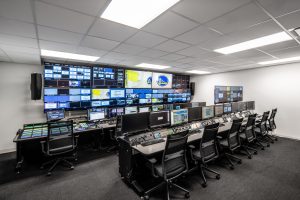
The IP-based control room was the base of virtual productions during the pandemic.
During the pandemic, this capability allowed the crew to flex its tech muscles and produce shows for fans when games were played behind closed doors. Prior to the start of the regular season, the Warriors produced Dubs Draft Room, a virtual experience that provided expert analysis of the club’s picks during the 2020 NBA Draft.
Throughout the regular season, the franchise took games to the next level with the creation of the Dub Hub, a multilayered digital planform with four exclusive camera angles and fan prompts reflected on a massive LED screen behind the bench. With lessons learned and knowledge obtained from those productions, the technical and creative teams boosted their confidence in the high-quality control room.
“Looking back on it, there are many more tools at our disposal to spin something like that up without a problem,” says Heitman. “We got to learn all about vMix and from other people in our industry to see how [these shows] work.”
Non–Game-Day Duties: Maintain Tech Infrastructure, Support Other Events
When the team is on the road or it’s the NBA offseason, the crew remains in full force, preparing for the next Warriors home schedule or supporting other events at Chase Center. Major events include occasional home games for the Santa Cruz Warriors, the team’s G League affiliate, and the final days of the NCAA Men’s Basketball Championship West Regional on Thursday, March 24 and Saturday, March 26. For the G League games, Heitman and his crew will assist producers of the Santa Cruz Warriors. As for March Madness, they’ll be busy switching up templates and workflows for college basketball.
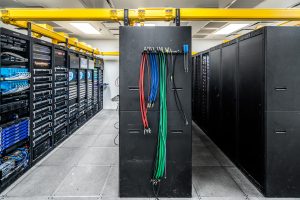
The venue’s rack room was built for further expansion.
“We need to make sure that we’re programmed for halves and for different shot and game clocks and loading in all of the teams’ logos for our displays,” says Heitman. “It’s also another package with different data and stats.”
When the control room isn’t busy, the staff runs routine maintenance checks, updates solutions, and fixes any bugs in the system. In addition, the crew will be at the center of the organization’s offseason meetings requiring dissemination of pertinent information.
“We’ll constantly work with our vendors to troubleshoot and make sure we have the latest firmware updates,” Heitman says. “We’ll also support our company-wide town-hall meetings that use our centerhung.”
New Improvements: In-Venue Shows Grow Since the Building Opened
After the onset of the pandemic and over three years of technological enhancements, the Warriors’ in-venue experience has positively changed since their first year in Chase Center. After an extended time with stringent COVID-19 guidelines and the ban on max-capacity crowds, fans are finally treated to a full show with all the bells and whistles during a successful season on the court. For any given game, the crew develops content that caters to both the traditional and modern fan, including 3D overlays and renderings of shot charts as well as real-time player stats, such as distance covered.
“We’ve wanted to step up our graphics to provide an immersive experience,” says Heitman. “Whether it’s your first game or you’re into statistics, we try to package [this information] in a way that’s eye-catching as well as useful.”
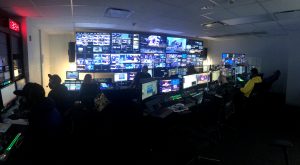
A look into the Chase Center control room during the Warriors-Grizzlies play-in game on May 21, 2021
The videoboard show exhibits more than advanced metrics. The Famous Group’s Vixi Live solution enables fans to scan a QR code on the videoboard and see their cellphone’s live video feed displayed as a Fan Cam.
“Our goal is to bring in the audience and make them feel like they’re part of the moment,” Heitman adds. “We have hundreds of fans participating in this, so we can bounce around [the arena] and show people on the LED centerhung.”
After numerous virtual and in-person productions, the crew is hitting their stride at Chase Center. With a unique balance between the two forms of shows, it has come a long way since the building’s doors were opened.
“When we started, there was so much that we didn’t know about our control room,” Heitman acknowledges. “We were still trying to understand how everything worked. Since then, we feel like we’ve figured it out.”
Lasting Impact: Chase Center Has Room for Additional Expansion
Heitman and his team continue to adapt to the challenges of live event production, with practically unlimited growth ahead of them. Ideas in the industry are expanding, and Chase Center was designed to accommodate new technological workflows. Thanks to IP-based video routing, the ceiling is as high as the creative team looks to go.
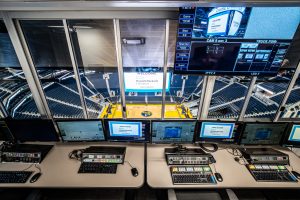
A view of the court from the control room
“We built Chase Center to be expandable and future-proof as much as possible,” he says. “We won’t have to replace a huge piece of gear if we want to go to 4K, 8K, HDR because we’re expanding our bandwidth and adding more resources to the infrastructure that already exists.”
From a storytelling perspective, Heitman sees multiple opportunities for the game presentation to expand as well. This includes chances to implement virtual reality, plotting out more camera angles, and displaying even more advanced statistics on the LED centerhung. As mobile and legalized sports betting becomes a mainstay, this real-time information can be crucial to the fan experience. Overall, the Warriors want to give fans many reasons to head out to Chase Center to watch entertaining basketball and have fun.
“Fans can watch the game at home on TV,” he notes, “but they’ve chosen to be here with us to see it in person. We want to make sure that decision is well worth their time and investment.”
The Golden State Warriors will play five more regular-season home games at Chase Center: Boston (3/16 at 10 p.m. ET), San Antonio 3/20 at 8:30 p.m.), Phoenix (3/30 at 10 p.m.), Utah (4/2 at 8:30 p.m.), and Los Angeles (4/7 at 10 p.m.).
